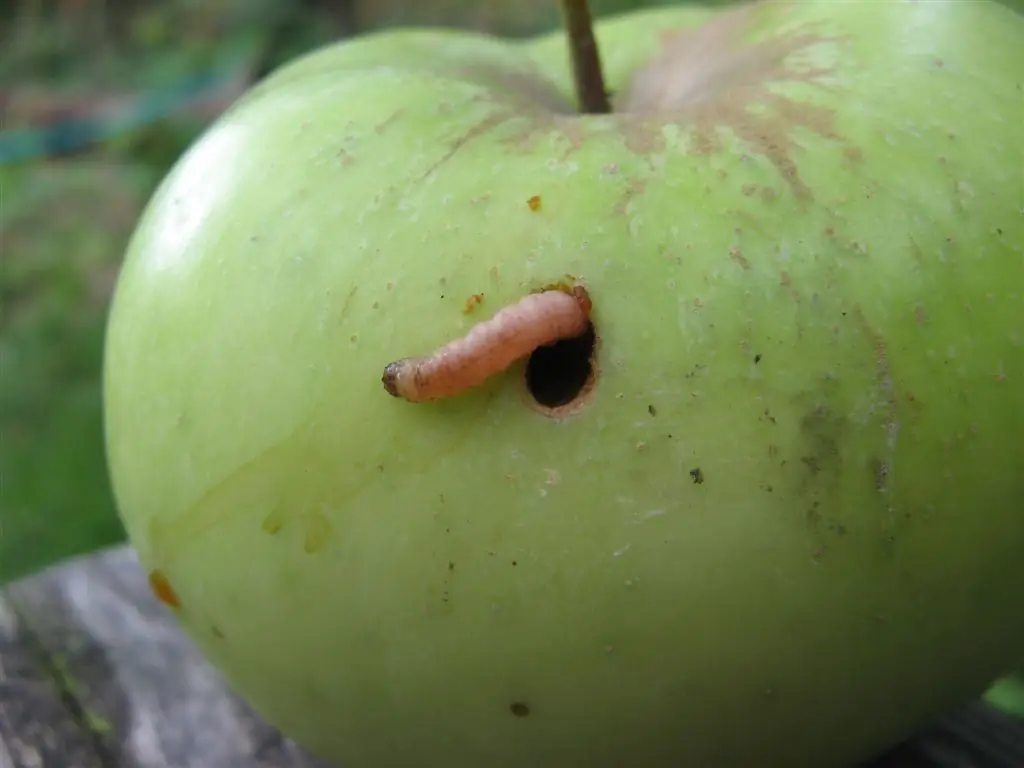
Table of contents:
- Author Bailey Albertson [email protected].
- Public 2023-12-17 12:53.
- Last modified 2025-01-23 12:41.
Greenhouse whitefly: what is the danger of a pest for the crop and how to deal with it

The greenhouse whitefly is a well-known pest of plantings of eggplants, tomatoes, sweet peppers, cucumbers and other vegetables. The insect is not averse to "feasting" on flowers and ornamental plants. No wonder the second name of the whitefly is greenhouse. The danger to plants from this pest is due not only to the fact that the insect damages the leaves. Whitefly can carry many pathogenic phytoviruses. That is why it is necessary to fight the pest at the first signs of plant damage, as well as timely take preventive measures to protect plants.
Content
-
1 Greenhouse whitefly: what is dangerous and how to detect
- 1.1 Insect biology
- 1.2 Nature of damage
- 1.3 Table: Whitefly Life Cycle and Pest Detection Methods
-
2 Greenhouse whitefly control measures
- 2.1 Chemical control methods
- 2.2 Folk remedies
- 3 Video: how to get rid of a whitefly
- 4 Reviews of gardeners on the fight against whitefly
Greenhouse whitefly: what is dangerous and how to detect
Greenhouse whitefly (Trialeurodes vaporariorum) is a pest of vegetable and ornamental crops in greenhouses. The whitefly is of tropical origin - Brazil and Mexico are considered the birthplace of the insect. Now the insect is widespread everywhere. It is transferred most often together with inhabited plants, less often due to independent flights of insects. Damaged crops:
- In the greenhouse: cucumber, tomato, watermelon, melon, pepper, parsley, celery, salad.
- In greenhouses and under indoor conditions, whitefly can damage ornamental plants: chrysanthemums, roses, azaleas, hibiscus, lemon, orange, tangerine, strawberries.
- In laboratory conditions, the whitefly can feed and reproduce on soybeans, tobacco, and makhorka.
Insect biology
The life cycle of an insect includes four periods: imago (adult), egg, larva, pupa. Females usually lay their eggs on plant leaves. Larvae of the first instar (vagabond) hatch from eggs in a week and begin to move. After a few days, having passed, in the next larval stages of development, the insect remains motionless, and in appearance it resembles a scale. Larva of last instar - pupa stops feeding. At 21 ° C, it takes about a month to reach the adult stage. Then an adult - an adult whitefly - flies out through the formed T-shaped slit. They usually make short flights, but can travel long distances through the wind.

An adult whitefly resembles a common mole
The nature of the damage
Whiteflies are sap-sucking insects in both the adult and larval stages. Typical symptoms of damage are the presence of honeydew on the surface of leaves and / or fruits. Honeydew can grow sooty fungi that interfere with photosynthesis and can make the fruit unsightly. A high degree of infestation reduces the overall vigor of the plant, leads to stunted growth and low yields. This pest can carry viruses: mosaic of tomato, cucumber, potato X-virus and others.

Gluttonous whitefly larvae feed on plant sap and thus cause them great harm
Table: whitefly life cycle and pest detection methods
| Stage of development | What does it look like | Where to find |
| Imago | 1.5 mm, at rest, the wings fold almost into one plane, covered with a white waxy coating | On the underside of the leaves |
| Egg | 0.25 mm in length, yellowish white, after 2 days turns gray with a violet tinge, conical in shape, on a short stem | On the underside of leaves, often in a (semi) ring shape |
| Larva | Small, usually pale green, oval, flattened, scale-like | On the underside of the leaves |
| Chrysalis |
0.8 mm long, whitish, oval, with fringes and downward wavy waxy bristles at the edge |
On the underside of the leaves |
Greenhouse Whitefly Control Measures
To prevent the spread of the pest, it is enough to take simple preventive and non-chemical control measures:
- Avoid planting infected plants. Buy seedlings only in trusted locations.
- The use of appropriate insect nets will prevent adults from entering the greenhouse during the summer.
- Removal of diseased plants in and around the greenhouse.
- The use of glue traps.
- The use of biological enemies of the whitefly, such as predatory wasps (Encarsia formosa, Eretmocerus eremicus), predatory bugs (for example Macrolophus pygmaeus or Nesidiocoris tenuis), beetles (Delphastus catalinae), ticks (Amblydromalus limonicussk, Amblyseius).

To reduce the harmfulness of the larvae, wipe the leaves with soapy water
Chemical control methods
If you decide to deal with a pest with special chemicals, consider the following rules:
- After one spraying of chemicals, only susceptible stages present at the time of treatment or during the period of time when the chemical remains active will die. At all other stages of development, the pest will survive and continue to develop. Thus, during the period of growing a crop, it may be necessary to carry out repeated treatments at intervals of several days.
- Many insecticides are available to combat the greenhouse whitefly, but there are already races of whitefly that are resistant to one or another drug. Therefore, strategies to prevent the development of resistance should be applied to maintain the effectiveness of insecticides.
- It is important to select insecticides and methods of application that do not harm biological control agents.
- Always follow the directions of the instructions for use: do not change the dosage, take precautions when working with insecticides.
For the chemical treatment of tomatoes, cucumbers and other vegetables, the following preparations are used:
- Fitoverm,
- Citkor,
- Phosbecid,
- Confidor,
- Actellik,
- Aktara,
- Vertimek,
- Pegasus.
For ornamental plants, it is recommended to use:
- Biotlin,
- Tsvetolux Bau,
- Novaktion,
- Inta-Ts-M.
Folk remedies
If the use of chemicals is unacceptable, use proven folk methods of pest control. Prepare the following products and treat the plants with them:
- Sugar solution. Dissolve 2 tbsp. sugar in 1 cup of water and treat leaves that show signs of whitefly damage. If it does not help, repeat spraying with the solution after a week.
- Infusion of garlic. Chop 15 g of garlic cloves and add 100 ml of water. Cover and leave for 5 days. The infusion will turn out to be very concentrated, therefore, to process plants, it is enough to dilute 5-6 g of infusion in 1 liter of water.
- Infusion of yarrow. Finely chop the herb of yarrow (80 g), scald with boiling water, pour 1 liter of water and leave for 24 hours. Treat diseased plants: if the leaves are large, wipe with a cotton swab dipped in the infusion, and for plants with small leaves, spraying will be more effective.
Video: how to get rid of a whitefly
Reviews of gardeners on the fight against whitefly
The greenhouse whitefly can significantly harm the quality and quantity of the crop. Adult insects and larvae literally suck vitality from plants and infect them with viruses. At the initial stage of the lesion, folk remedies and further adherence to prevention can be effective. However, if the whitefly population has grown, it is necessary to resort to the use of chemicals.
Recommended:
Control Measures For The Moth (apple, Plum, Etc.): Folk And Chemical Methods

Detailed descriptions of methods for controlling the apple and plum moth. Folk methods, recipes. Chemical treatment
Cat Lichen In Humans: Signs Of Whether The Disease Is Transmitted From An Animal, Features Of The Treatment Of The Cat And The Owner, Prevention, Photo

Characteristics of the disease, types, symptoms in cats and humans. Diagnostic rules. Traditional and non-traditional methods of treatment. Prevention rules
Toyger Cat: Photo, Breed Description, Content Features, Owner Reviews

Where the breed was bred, external differences and character traits, how to properly care for a toyger, how to feed, how to choose a kitten. Owner reviews
How To Process A Greenhouse From A Whitefly: Means, Timing, Reviews And Video

How to treat a greenhouse from a whitefly. What folk remedies can be used to combat whitefly
How To Change Your Hairstyle Without Drastic Measures

If you want to change, you don't have to cut your hair or drastically change its color. You can quickly and easily, with minimal effort, become bright
